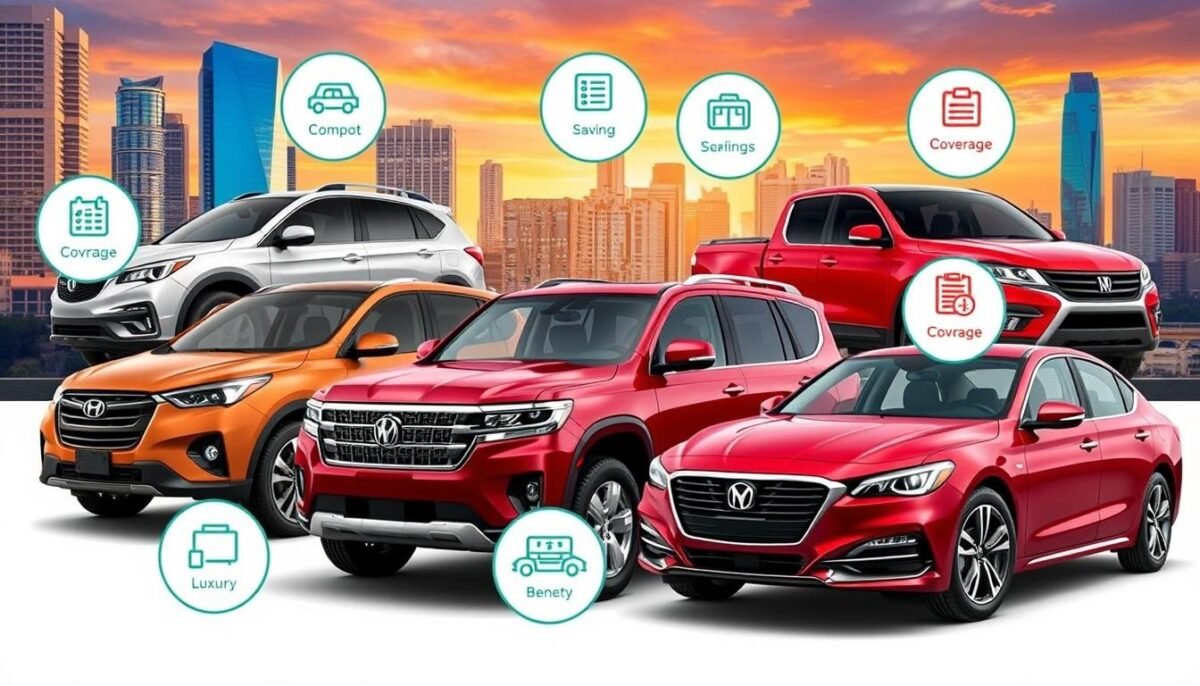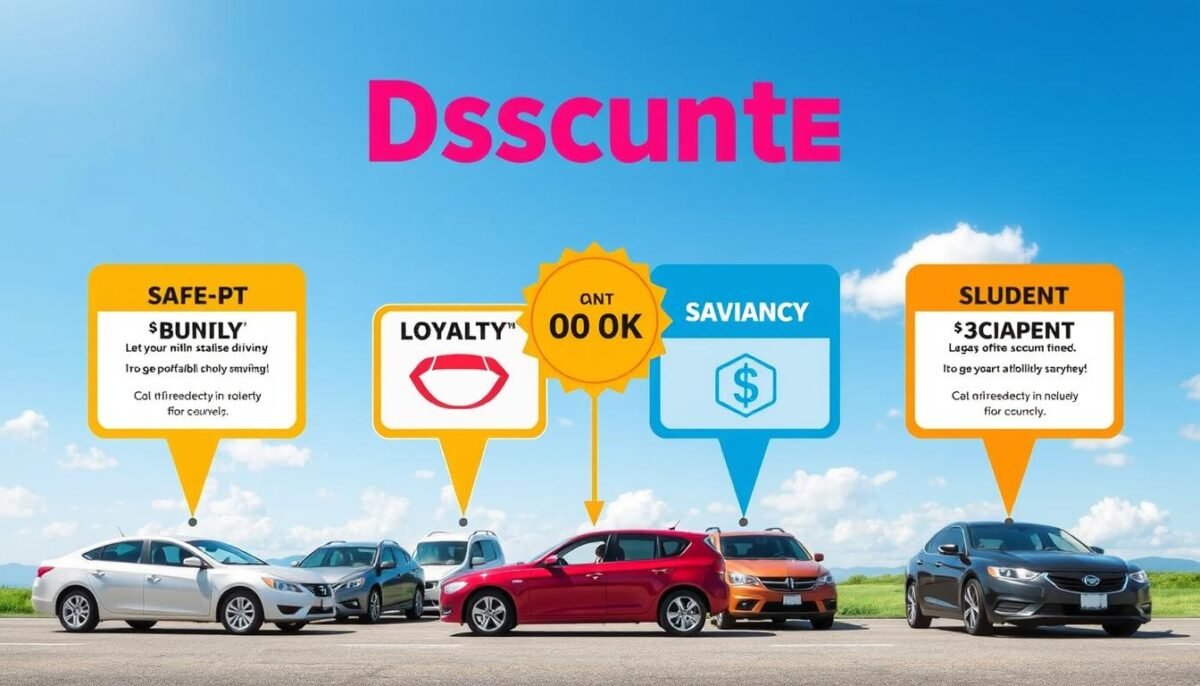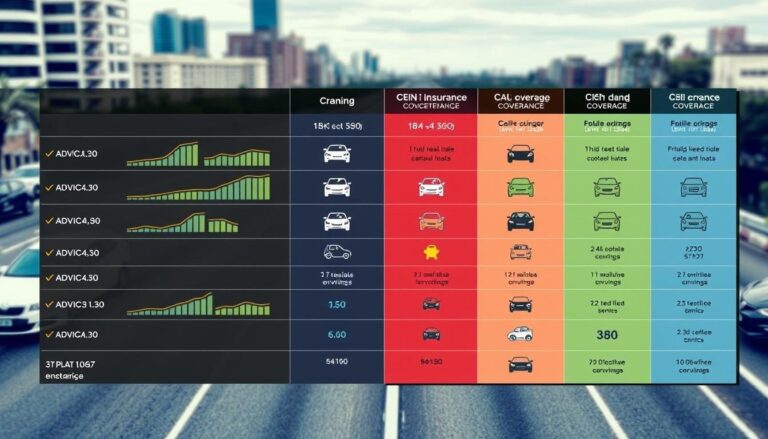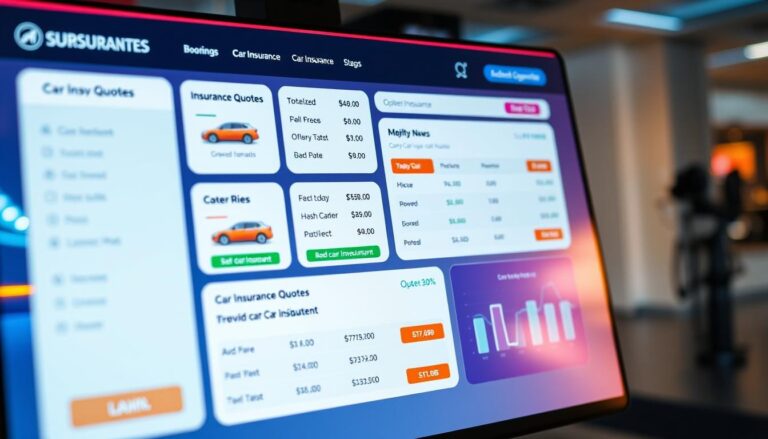Ever wondered why your car insurance is different from your neighbor’s, even if you both drive the same car? The answer is in the details of car insurance comparisons. In this guide, we’ll explore what affects your car insurance rates. We’ll help you find the best coverage for your car.
Key Takeaways
- Understand the different types of car insurance coverage and how they impact your rates
- Discover the significant impact your vehicle’s make, model, and features have on insurance costs
- Learn how to effectively compare insurance quotes and find the most personalized coverage for your needs
- Explore the top insurance companies and their unique features to make an informed decision
- Uncover strategies to maximize your savings through available discounts and a clean driving record
So, what’s the secret to finding the best car insurance rates? It’s all about the details. Let’s dive into the world of car insurance comparisons. We’ll show you how to get the most affordable coverage for your car.
Understanding Car Insurance Basics
Protecting your vehicle is key, and knowing car insurance basics is essential. Car insurance usually covers liability, collision, and comprehensive. Liability helps if you’re at fault in an accident and hurt others. Collision pays for your car’s repairs if you hit something. Comprehensive covers theft, vandalism, or natural disasters.
The cost of car insurance changes a lot. It depends on your car’s make, model, age, and safety features. Cars with high repair costs or less safety tech cost more to insure.
Types of Car Insurance Coverage
- Liability Coverage: Protects you if you’re responsible for damages or injuries to others
- Collision Coverage: Covers repairs to your vehicle if you collide with another car or object
- Comprehensive Coverage: Protects against non-collision events like theft, vandalism, or natural disasters
Factors Influencing Insurance Costs
- Vehicle Make and Model: Cars with higher repair costs or less safety features tend to have higher insurance premiums
- Vehicle Age: Newer vehicles generally cost more to insure than older vehicles
- Safety Features: Vehicles with more advanced safety technologies may qualify for discounts
- Driving Record: A clean driving history with no accidents or violations can help lower your rates
Knowing these basics helps you choose the right car insurance. It’s important when comparing car insurance quotes by make and model to find the best for your car and driving habits.
Why Compare Car Insurance by Vehicle
Car insurance isn’t a one-size-fits-all deal. The car you drive affects your car insurance premiums and what coverage you need. It’s key to compare car insurance pricing by automobile to get the right policy for you.
Differences in Rates by Make and Model
Insurance companies look at the risk of different cars. Things like safety features, repair costs, and theft rates matter. For instance, sports cars might cost more to insure than minivans because they’re more likely to crash or get stolen.
Importance of Personalization in Coverage
When you look at car insurance, think about your car’s special features. Its age, mileage, and how you use it can change what coverage you need and how much you’ll pay. Personalizing your insurance means you pay for what you really need, not too much.
Comparing car insurance by vehicle is a smart move. It helps you find the best coverage and rates for your car. Knowing how pricing and personalization work lets you make a choice that fits your car and your wallet.

“Comparing car insurance by vehicle can save you hundreds, if not thousands, of dollars each year on your premiums.”
How to Start the Car Insurance Comparison Process
Comparing insurance quotes by car model and auto coverage comparison by car might seem hard. But, with the right steps, it’s easy. We’ll show you how to start by gathering info and using helpful tools.
Gathering Necessary Information
To begin, collect all important details about your car and driving history. This includes:
- The make, model, and year of your car
- Your driving record, including any accidents or traffic violations
- Your current insurance coverage and limits
- Your estimated annual mileage
- Your preferred coverage options and deductibles
Using Tools and Resources
After gathering your info, use online tools and resources to compare. These tools make finding insurance quotes by car model and auto coverage comparison by car easy. Some top tools include:
- Car insurance comparison websites that give you quotes from many insurers
- Mobile apps for quick insurance rate updates and policy management
- Insurance company websites with detailed coverage and discount info
- Consumer review sites for insights on different insurance providers
These tools help you quickly gather and compare the info you need. This way, you can make a smart choice about your car insurance.
“Comparing car insurance rates is essential to finding the best coverage for your needs and budget.”
Top Insurance Companies to Consider
Finding the right vehicle insurance is key. Look at the top insurers in the U.S. State Farm, GEICO, and Progressive offer unique features and benefits. Knowing what each company specializes in helps you choose the best fit for your needs.
Overview of Major Insurers
State Farm is the biggest auto insurance company. It’s known for its financial strength and wide agent network. GEICO is popular for its easy-to-use website and competitive rates. Progressive stands out with its innovative tools and personalized coverage.
Unique Features and Benefits
- State Farm: Offers financial stability, a large agent network, and many coverage options like liability and collision.
- GEICO: Provides a smooth online experience, competitive rates, and discounts for good drivers and military members.
- Progressive: Known for its unique insurance premium calculator by car and customizable coverage.
Exploring what each top insurer offers helps you make a smart choice. This ensures you get the right coverage and service for your vehicle.
Analyzing Quotes Effectively
Comparing car insurance quotes can seem tough. But, with the right steps, you can find the best deal. Let’s look at how to analyze insurance quotes well.
Understanding Insurance Jargon
First, you need to understand insurance terms. Words like “deductible,” “coverage limits,” and “liability” might confuse you. Before you start, learn these terms. Knowing them helps you compare quotes better and choose the right coverage.
Comparing Apples to Apples
When looking at quotes, make sure they offer the same coverage. Insurance companies have different options. It’s important to compare similar policies. This way, you can see the real differences in car insurance comparison by car and auto insurance rates by vehicle.
| Coverage Type | Company A | Company B | Company C |
|---|---|---|---|
| Liability Limits | $100,000/$300,000 | $100,000/$300,000 | $50,000/$100,000 |
| Collision Deductible | $500 | $1,000 | $500 |
| Comprehensive Deductible | $250 | $500 | $250 |
| Annual Premium | $1,200 | $1,100 | $900 |
Organizing coverage details in a table makes it easy to see differences. This helps you choose based on your needs and budget.
“Comparing car insurance quotes is like shopping for the perfect fit – you want to find the coverage that protects you without breaking the bank.”
Discounts and Savings Opportunities
Looking at car insurance quotes by make and model can help you find great rates. But, insurance companies also offer discounts that can save you even more. It’s important to look for these discounts when comparing vehicle-specific car insurance costs.
Common Discounts Offered
Insurance companies give discounts for certain things. These include:
- Multi-policy discount: Getting your car insurance with other policies, like home or life, can save a lot.
- Safe driver discount: If you drive safely and don’t get into accidents, you might get this discount.
- Good student discount: Students with a high GPA can get a lower rate.
- Defensive driving course discount: Taking a safe driving course can show you’re serious about driving well and lower your rates.
- Loyalty discount: If you stay with the same insurance company for a while, you might get a discount.
Tips for Maximizing Savings
To get the most savings, follow these tips when comparing car insurance quotes by make and model:
- Give accurate info: Make sure your driving history and vehicle details are correct to get the right discounts.
- Ask about all discounts: Don’t assume you’re getting all discounts. Always ask your insurance company about what you qualify for.
- Check your policy often: Review your policy and ask about new discounts or changes that might apply to you.
- Think about bundling: Getting your car insurance with other types of insurance can save you a lot through multi-policy discounts.
By using the discounts and savings available, you can compare car insurance quotes by make and model. This way, you can find the best coverage for your vehicle and driving habits.

The Impact of Your Driving History
Your driving history greatly affects your car insurance rates. Claims and traffic violations can raise your premiums. Keeping a clean driving record is key to getting the best rates.
How Claims and Violations Affect Rates
Insurers see drivers with many claims as higher risks. This can increase your premiums. Traffic violations, like speeding tickets, also raise rates.
Insurers use this info to predict future claims. They adjust rates based on this.
Importance of a Clean Record
- Drivers with no claims or violations get the best rates.
- A clean record shows you’re a responsible driver. This can save you money.
- Staying accident-free and following traffic laws helps keep your rates low.
| Driving History Factor | Impact on Car Insurance Premiums |
|---|---|
| No Claims or Violations | Lowest Car Insurance Premiums by Car Type |
| Multiple Claims | Higher Car Insurance Pricing by Automobile |
| Traffic Violations | Increased Car Insurance Premiums by Car Type |
Your driving history is a big factor in your car insurance rates. A clean record and fewer claims can get you better rates. This means you’ll have more peace of mind with good coverage.
Reviewing Customer Service and Claims Support
When you’re looking at car insurance, don’t just focus on price and coverage. The quality of customer service and claims support is key. It can greatly affect your experience as a policyholder. Here are some important things to look for when checking an insurer’s customer service and claims support.
Key Indicators of Good Customer Service
- Prompt and responsive communication, whether by phone, email, or online chat
- Easy-to-navigate website and mobile app with self-service features
- Knowledgeable and helpful representatives who can address your questions and concerns
- Flexible and accommodating policies, such as the ability to make policy changes or file claims online
How to Research Customer Satisfaction
To understand an insurer’s customer service and claims support, do your homework. Here’s how:
- Check industry ratings and reviews from trusted sources, such as J.D. Power, the Better Business Bureau, and customer review websites
- Look for information on the insurer’s website about their customer service metrics, such as average response times and first-call resolution rates
- Reach out to your network and ask for personal recommendations or experiences with different insurance providers
- Consider factors like the insurer’s complaints ratio and how they handle and resolve customer issues
By carefully reviewing an insurer’s customer service and claims support, you can pick a provider that will support you when you need it. This can give you peace of mind. It helps you make a better choice when comparing auto coverage by car model and getting the best insurance quotes by car model.

Making the Final Decision
As you get close to choosing your car insurance, it’s key to look at everything you’ve checked. You should compare rates, coverage, and the reputation of insurance companies. But, your final choice should also consider what you really need and like.
Evaluating All Factors Before Committing
Before picking a car insurance policy, take time to look at the coverage, costs, and customer service. Make sure the coverage fits your driving, car value, and money situation. Also, check how they handle claims, if they offer discounts, and if they’re financially stable.
Ensuring You Have the Right Coverage
The last step is to make sure your chosen policy covers your car and driving needs well. Check the policy limits, deductibles, and any things not covered. Remember, the cheapest might not always be the best. It’s important to find a balance between cost and coverage that makes you feel safe driving.
FAQ
What factors influence car insurance rates by vehicle?
The type of car, its safety features, repair costs, and theft likelihood affect insurance rates. Cars with high safety ratings, low repair costs, and low theft risk have lower premiums.
How can I compare car insurance quotes by make and model?
To compare car insurance quotes, gather info on your vehicle like year, make, model, and trim. Use online tools to request quotes from different insurers. This lets you compare coverage and prices for your car.
Why is it important to have personalized car insurance coverage?
Personalized car insurance is key because it matches your vehicle and needs. Premiums vary based on car value, safety features, and driving history. A one-size-fits-all approach might not be the best or most affordable.
What information do I need to start the car insurance comparison process?
To start comparing car insurance, gather details about your vehicle and driving history. Include your vehicle’s year, make, model, and trim, as well as your driving history and desired coverage levels.
Which major insurance companies should I consider for vehicle-specific coverage?
Consider State Farm, Geico, Progressive, Allstate, and Farmers for vehicle-specific coverage. These insurers offer specialized programs for different car models and their insurance needs.
How can I effectively analyze and compare car insurance quotes?
To compare car insurance quotes well, understand insurance terms and compare coverage levels and deductibles. This way, you can make a fair comparison and find the best policy for your car.
What are some common car insurance discounts I should look for?
Look for discounts like multi-policy, safe driver, good student, and safety feature discounts. These can help you save on your car insurance.
How does my driving history impact car insurance rates?
Your driving history, including claims and violations, affects your rates. Insurers see drivers with clean records as lower-risk. So, a good driving history can lead to better rates, regardless of your car.
What should I look for in terms of customer service and claims support when comparing insurers?
When comparing insurers, look at customer service and claims support. Check customer satisfaction ratings, the claims process, and 24/7 support. A reliable insurer can offer peace of mind when you need it.
What final factors should I consider before making a decision on car insurance?
Before choosing car insurance, consider price, coverage, customer service, and the insurer’s reputation. Make sure you have the right coverage for your car and needs. This way, you can drive with confidence, knowing you’re protected.



